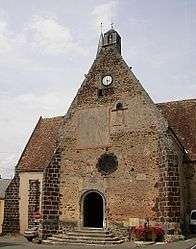Sargé-sur-Braye
| Sargé-sur-Braye | ||
|---|---|---|
|
The church of Saint-Cyr, in Sargé-sur-Braye | ||
| ||
 Sargé-sur-Braye | ||
|
Location within Centre-Val de Loire region  Sargé-sur-Braye | ||
| Coordinates: 47°55′28″N 0°51′14″E / 47.9244°N 0.8539°ECoordinates: 47°55′28″N 0°51′14″E / 47.9244°N 0.8539°E | ||
| Country | France | |
| Region | Centre-Val de Loire | |
| Department | Loir-et-Cher | |
| Arrondissement | Vendôme | |
| Canton | Mondoubleau | |
| Intercommunality | Communauté de communes des Collines du Perche | |
| Government | ||
| • Mayor (20014-2020) | Jean Léger | |
| Area1 | 42.61 km2 (16.45 sq mi) | |
| Population (2012)2 | 1,045 | |
| • Density | 25/km2 (64/sq mi) | |
| Time zone | CET (UTC+1) | |
| • Summer (DST) | CEST (UTC+2) | |
| INSEE/Postal code | 41235 / 41170 | |
| Elevation |
78–202 m (256–663 ft) (avg. 90 m or 300 ft) | |
|
1 French Land Register data, which excludes lakes, ponds, glaciers > 1 km² (0.386 sq mi or 247 acres) and river estuaries. 2 Population without double counting: residents of multiple communes (e.g., students and military personnel) only counted once. | ||
Sargé-sur-Braye is a commune in the Loir-et-Cher department of central France.
Its inhabitants are called Sergetières and Sergetiers.
Geography
The commune is bathed by the Braye and the Grenne rivers, which join here before leading as the Braye to the Loir. The town is a part of the Canton of Mondoubleau. It is bordered to the north by Cormenon, to the south by Savigny-sur-Braye, to the east by Épuisay and to the west by Saint-Calais.
History
Between 29 January and 8 February 1939, more than 3,100 Spanish refugees fleeing the collapse of the Spanish Republic under Franco, arrived in Loir-et-Cher. Faced with a lack of buildings to welcome them (the stud farm at Selles-sur-Cher had been used), 47 villages provide accommodation,[1] including Sargé-sur-Braye.[2] The refugees, essentially women and children, were subjected to a strict quarantine and vaccinated. Mail was limited. Supplies, though lacking variety and cooked the French way, were, however, assured.[3] In the spring and summer, the refugees were regrouped at Bois-Brûlé (commune of Boisseau).[4]
Sights and monuments
- Église Saint-Martin. This church been listed since 1958 as a monument historique by the French Ministry of Culture. Dating originally from the 10th century, its present form is from 1549. There are traces of 14th century painted murals.[5]
- Église Saint-Cyr, and its jacquemart.
- Château des Radrets has been listed since 1977 as a monument historique. Parts of it date back to the 15th century; it was extensively altered in the 18th.[6]
- Château de Montmarin has been listed since 1986 as a monument historique. Originally 17th century, it was altered in the 18th and 19th.[7]
- Château du Fief Corbin
- Roussard quarry
See also
References
- ↑ Jeanine Sodigné-Loustau, "L'accueil des réfugiés civils espagnols de 1936 à 1940. Un exemple : la région Centre", Matériaux pour l'histoire de notre temps. 1996, no 44. p. 43.
- ↑ Jeanine Sodigné-Loustau, op cit, p. 47.
- ↑ Jeanine Sodigné-Loustau, op cit, p. 43-44.
- ↑ Jeanine Sodigné-Loustau, op cit, p. 46.
- ↑ Ministry of Culture: Eglise Saint-Martin (French)
- ↑ Ministry of Culture: Château des Radrets (French)
- ↑ Ministry of Culture: Château de Montmarin (French)
External links
| Wikimedia Commons has media related to Sargé-sur-Braye. |
- Ministry of Culture listing for Eglise Saint-Martin (French) and Ministry of Culture photo
- Ministry of Culture listing for Château des Radrets (French) and Ministry of Culture photos
- Ministry of Culture listing and photo for Château de Montmarin (French)

.svg.png)